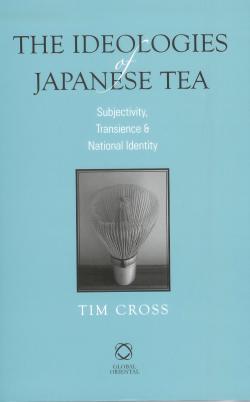By Tim Cross, Global Oriental, 2009, 312 pages including index, bibliography and notes, ISBN 978-1-905246-74-8
Review by Sir Hugh Cortazzi
Tim Cross, who teaches courses related to tea, noh and contemporary literature in Kyushu, is a practitioner of tea as well as of noh singing and dancing.
Cross explains that his book “maps how the pleasures of tea were useful in the invention of a particular form of Japaneseness. Tea precepts such as purity, harmony and respectful appreciation of social stability will be shown to be coercive forces that became keywords in the official definition of wartime Japanese identity, a sacrament that demanded the ultimate sacrifice.” This thought is further explained by Andrew Cobbing of Nottingham University who has written an introduction entitled “Tea, Aesthetics and Power.” In this he says: “At first glance, the aesthetic imagery surrounding the tea ceremony seems innocent enough: transience, ephemerality, purification and the beauty of cherry blossoms falling in their prime. Yet in the context of military conflict, embodied within this symbolism is a potentially lethal discourse of transience with a practical application in the theatre of war.”
Cross begins with a description of “twenty first century tea.” This is followed by a chapter entitled “Inventing the nation, Japanese culture politicizes nature” in which he notes that for tea masters “all flowers are not created equal.” Tea masters do not care for flowers that remain long in bloom. The next chapter is headed “Lethal Transience” in which Cross argues among other things that “This other world of tea allowed Japaneseness to be defined in a manner that blurred the boundaries between the worlds of nature and society.” He notes that the famous cherry blossom at Yoshino not only announce the arrival of spring but “link imperial power, martial struggles for power and natural divinity.”
The next chapter entitled “Japanese Harmony as Nationalism: Grand Master Tea for War and Peace” is based on the premise that “tea operates as cultural nationalism inside the discourse of state nationalism.” Chapter 5, which is headed “Wartime tea literature, Rikyū, Hideyoshi and Zen,” recounts the relationship between Rikyū and Hideyoshi and Sen no Rikyū’s ritual suicide which was regarded as “the embodiment of the calm decisiveness of Zen.” Cross describes war-time Japanese propaganda as an “early twentieth century appeal to the role of Japan as an agent of global harmony at the point of a sword.” On page 115 he writes: “The ideological linkage between Zen and tea as patriotic forces commences with the 1906 rendition by Okakura [Kakushin] of Rikyū smiling as he took his own life in 1591. The 1915 invention of war Zen is compounded by the 1943 appearance of combat zazen [kamikaze pilots were sent to do zazen [坐禅] before their final suicidal mission]. The image of Rikyū facing his own death was a role model for members of the Imperial Forces who were conscripted into Soldier Zen.”
Chapter 6 on the “Grand Master: Iemoto” and chapter 7 headed “The Teachings as Power Questioning Legitimate Authority” are critical of a system which is open to corruption and abuse, but which reflects the Japanese penchant for hierarchy and respect for age and position. Chapter 6 also discusses the way in which tea is dealt with in Yasunari Kawabata’s [川端 康成] novel Thousand Cranes [千羽鶴]. The next two chapters deal with films and take up some controversies in which Cross has been involved. The final chapter on “National Identity and Tea Subjectivity” takes as its theme the following opaque question: “Could it be that a post-modern subject for nation may be emerging for whom nation as independent nation state matters somewhat less than nation as culture?”
The value of this book lies in its exposure of the way that the tea ceremony and its concomitant philosophy has been exploited to boost Japanese nationalism and the concept of Japanese uniqueness. Unfortunately the book is written in a dense style with many convoluted sentences. This means that some long sentences need to be read at least twice before their meaning becomes apparent.



